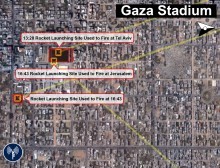Israel managed to deal Hamas’ rocket arsenal a “very harsh blow” and wipe out the terror’ group’s drone aircraft during Operation Pillar of Defense, an IDF spokeswoman told The Mideast Update on Thursday. The recap of the week-long bombardment campaign comes after the Israel-Gaza conflict officially concluded Wednesday night in a ceasefire brokered by Egypt. Israel has already begun the process of releasing reservist soldiers who had been drafted for the conflict.
Lt. Col. Avital Leibovich told The Mideast Update that the IDF damaged the Hamas and Islamic Jihad “commander infrastructure” in the operation by targeting many brigade-level commanders and the head of the Hamas military wing, Ahmad Jabari.
When asked how the impact of the recent offensive on the Hamas terrorist leadership compared to past IDF efforts, including the 2009 Operation Cast Lead war, Leibovich said that “Pillar of Defense” was “more severe than in the past,” including in that the targeting of Hamas’ infrastructure. The conflict that launched last Thursday saw the IDF strike 1,500 Gaza targets, including Hamas’ aforementioned unmanned aircraft program.
“We took out the entire drone arsenal,” Leibovich said. “Hamas bought some of them, tried to deal with them, develop them, drill with them, and with good intelligence we were able to take it out.” That achievement comes after Lebanon’s Hezbollah group surprisingly was able to fly a drone over Israel in October.
Hamas was able to fire 1,500 rockets at Israel in the recently-concluded conflict, including multiple rockets that reached the Tel Aviv and Jerusalem areas. Despite that, Leibovich pointed out that just 7% of the Gaza rockets ultimately hit Israeli urban areas, in large because because the Iron Dome missile defense system intercepted more than 400 threatening missiles.
Israel also was able to strike hard at the Gaza rocket stockpiles. “We have such good intelligence that we were able to detect their underground launchers and take many of them out. So I would say with the long-range [rockets] a severe blow [was dealt], and with the medium-range, I would say that it was a significant blow,” said Leibovich in the interview. She noted that the long-range Fajr 5 missiles, which reached the Tel Aviv and Jerusalem areas, are easier to hit since they have built-in launchers, whereas the medium-range Grad rockets are on mobile launchers.
Despite the ceasefire agreement, Gaza rocketfire continued, with at least five rockets launched at Israel. Leibovich said two were intercepted by the Iron Dome and the others all hit the ground. The IDF held it’s fire, but Leibovich warned such would not always be the case in the future. “If tomorrow morning, another launching squad will try to launch a rocket at Israel, we will hit that launching squad, but we won’t initiate any proactive operations.”
Overall, Leibovich said “Operation Pillar of Defense” was an IDF success. “We achieved all the goals that we set for ourselves. I can tell you that the moral is very high among the soldiers.”
(By Joshua Spurlock, www.themideastupdate.com, November 22, 2012)

